Ci sono stati momenti in cui tutto sembrava a posto in WordPress, ma il link del post mostrava un errore 404. Nessuna modifica al contenuto, solo una pagina mancante che avrebbe dovuto esserci.
Questo di solito compare dopo aver modificato le impostazioni, cambiato tema o aggiunto codice che influisce silenziosamente sui permalink. Può coglierti di sorpresa, soprattutto se il resto del tuo sito funziona perfettamente.
Ogni volta che ci imbattiamo in errori 404 inaspettati, seguiamo un semplice processo per ripristinare gli URL dei post, senza congetture o complicate risoluzioni dei problemi. Ed è esattamente quello che condividiamo con te in questa guida.
Sarai in grado di correggere gli errori 404 e assicurarti che i tuoi post vengano caricati come dovrebbero.
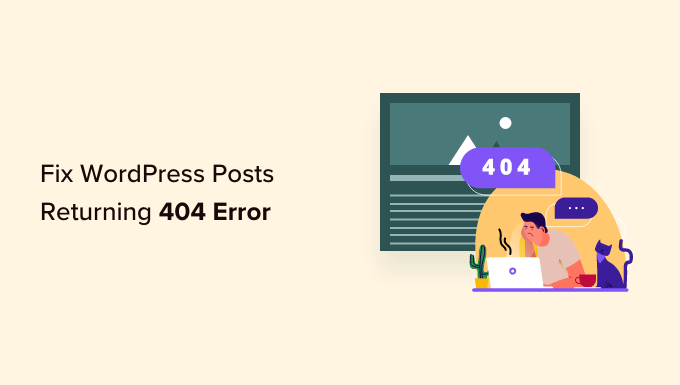
Perché i miei post di WordPress restituiscono un errore 404?
Ci sono diverse ragioni per cui i tuoi post potrebbero mostrare un errore 404 "Pagina non trovata" in WordPress. Queste possono includere:
- Conflitti tra plugin o temi: A volte, i plugin o i temi che hai installato sul tuo sito possono interferire con il modo in cui WordPress gestisce i permalink. Questo può portare a link interrotti ed errori 404.
- Problemi con codice personalizzato: Se hai aggiunto codice personalizzato al tuo sito web, potrebbero esserci errori nel codice che influiscono sui permalink o causano altri conflitti, con conseguenti errori 404 per i tuoi post.
- Problemi con il tuo file .htaccess: Il file .htaccess svolge un ruolo nel modo in cui WordPress struttura gli URL. Se questo file è corrotto o mancante, può causare errori 404 per i tuoi post o pagine.
Come trovare tutti i post di WordPress con errori 404
Prima di passare alle soluzioni, sarebbe utile capire se questo errore si verifica solo per uno o due post o per più post. In questo modo, puoi determinare l'entità del problema e scegliere la soluzione più appropriata.
Un modo semplice per scoprirlo è utilizzare Google Search Console. Se non hai ancora inviato il tuo sito a Google Search Console, leggi la nostra guida su come aggiungere il tuo sito WordPress a Google Search Console.
Una volta che il bot di Google ha scansionato e indicizzato il tuo sito, Google Search Console ti fornirà informazioni dettagliate sulle prestazioni del tuo sito, inclusi eventuali errori 404 che incontra.
Per scoprire quali post restituiscono errori 404, puoi accedere alla dashboard di Search Console. Quindi, naviga nel report 'Pagine' e vedrai un elenco dettagliato di tutti gli errori.
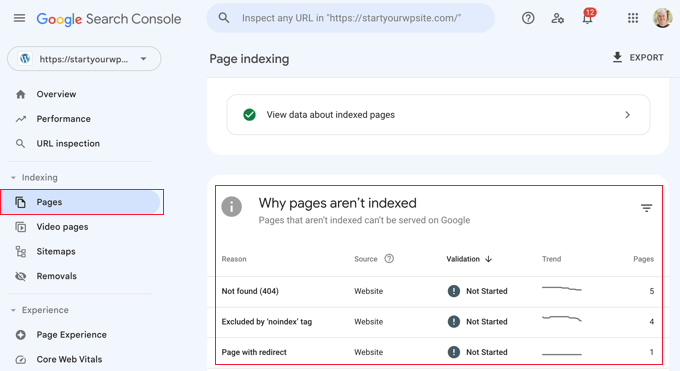
Per ulteriori informazioni, puoi leggere il nostro elenco di suggerimenti per l'utilizzo di Google Search Console per aumentare il traffico del sito web, che include alcuni suggerimenti su come correggere gli errori 404 con lo strumento.
Detto questo, vediamo come correggere i post di WordPress che restituiscono errori 404. Puoi utilizzare i link sottostanti per passare direttamente a diverse soluzioni:
- Metodo 1: Verifica conflitti di plugin o temi e problemi di codice personalizzato
- Metodo 2: Correggi le impostazioni dei tuoi Permalink
- Metodo 3: Aggiorna il file .htaccess di WordPress
- Metodo 4: Contatta il tuo provider di hosting
- Method 5: Enable mod-rewrite (Local WordPress Installation)
- Domande frequenti sugli errori 404 di WordPress
- 🎁 Bonus: Guida aggiuntiva sulla gestione degli errori 404
Metodo 1: Verifica conflitti di plugin o temi e problemi di codice personalizzato
A volte, plugin, temi o codice personalizzato che hai aggiunto al tuo sito web WordPress possono interferire con i permalink o causare conflitti, portando a errori 404. L'abbiamo sperimentato anche noi stessi quando testiamo strumenti sul nostro sito demo.
Un modo per risolvere questo problema è disattivare temporaneamente i plugin. I plugin a volte possono interrompere il modo in cui WordPress gestisce i link.
Una volta disattivati i plugin, puoi riattivarli uno per uno controllando se l'errore 404 ricompare dopo aver attivato ciascun plugin. Se l'errore si presenta dopo aver attivato un plugin specifico, quello potrebbe essere il colpevole.
Puoi quindi effettuare una rapida ricerca su Google per trovare soluzioni relative a quel plugin o contattare lo sviluppatore del plugin per assistenza.
Allo stesso modo, il tuo tema WordPress potrebbe causare il conflitto.
Per verificarlo, puoi passare temporaneamente a un tema WordPress predefinito come Twenty Twenty-Three o Twenty Twenty-Four. Tutto ciò che devi fare è andare su Aspetto » Temi e fare clic su 'Attiva' su un tema predefinito.

Se l'errore 404 scompare con il tema predefinito, ciò indica un potenziale conflitto con il tuo tema attuale. Puoi quindi provare a risolvere i problemi del tema o considerare l'utilizzo di un tema diverso.
Puoi consultare la nostra selezione di esperti dei temi WordPress più popolari per raccomandazioni.
Se hai recentemente inserito snippet di codice sul tuo sito web, potrebbero esserci errori nel codice che causano gli errori 404. Dai un'occhiata attenta al codice che hai aggiunto e vedi se riesci a identificare eventuali errori.
Il modo più sicuro per aggiungere snippet di codice a WordPress è con il plugin WPCode. Questo plugin ti consente di inserire codice personalizzato senza lavorare direttamente con i file del tema, riducendo il rischio di compromettere il tuo sito web.
Inoltre, ogni volta che WPCode rileva un errore nel tuo codice, disattiverà automaticamente lo snippet e ti chiederà di controllarlo. Puoi anche utilizzare la modalità di test per verificare se il tuo codice funziona prima di pubblicarlo sul tuo sito web live.
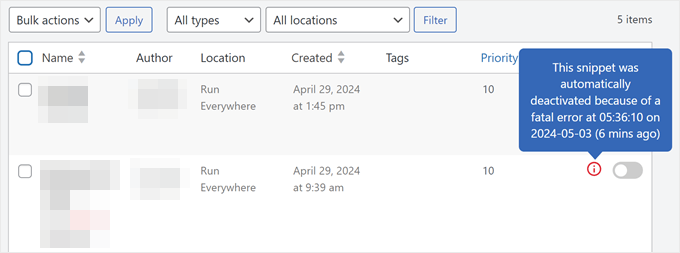
Se nessuna di queste soluzioni funziona, passa al metodo successivo in cui risolveremo i problemi relativi alle impostazioni dei tuoi permalink.
Metodo 2: Correggi le impostazioni dei tuoi Permalink
I post di WordPress possono restituire errori 404 a causa di problemi con le regole di riscrittura nel tuo file .htaccess. Nella maggior parte dei casi, puoi risolvere il problema aggiornando le impostazioni dei tuoi permalink.
Vai semplicemente su Impostazioni » Permalink nella tua bacheca di WordPress e fai clic sul pulsante 'Salva modifiche'.
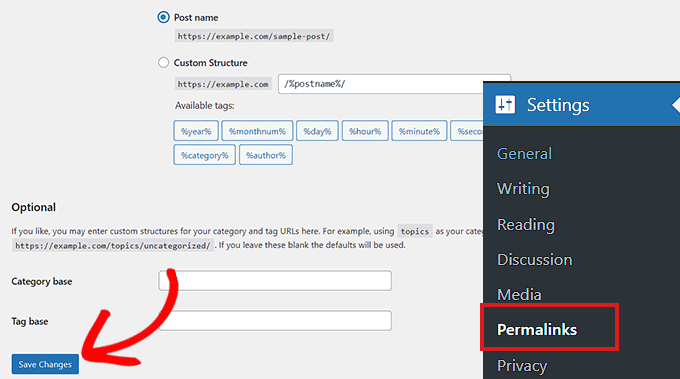
Non è necessario apportare modifiche alle impostazioni dei permalink stesse. Questo aggiornerà le tue impostazioni dei permalink e svuoterà le regole di riscrittura.
Nella maggior parte dei casi, questa soluzione risolve l'errore 404 dei post di WordPress. Tuttavia, se non funziona per te, probabilmente dovrai aggiornare manualmente il tuo file .htaccess.
Metodo 3: Aggiorna il file .htaccess di WordPress
Prima di iniziare, assicurati di eseguire il backup del tuo file .htaccess di WordPress. Se qualcosa va storto, puoi facilmente ripristinare il file originale.
Ora dovrai connetterti al tuo server utilizzando un client FTP come FileZilla o il File Manager nel tuo pannello di controllo di hosting.
Successivamente, trova il file .htaccess nella cartella principale del tuo sito: questa è la stessa directory che contiene cartelle come /wp-content/ e /wp-includes/.
Fai clic destro sul file e seleziona 'Permessi file' o 'Cambia permessi' dal tuo client FTP.
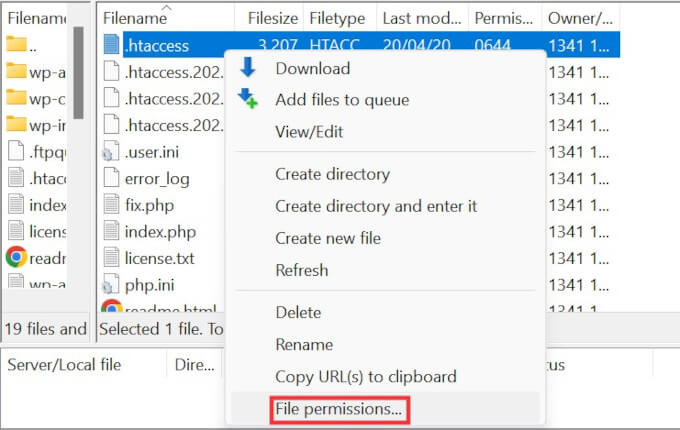
Se WordPress non è riuscito a scrivere sul file in precedenza, prova a cambiare temporaneamente i suoi permessi a 666 per renderlo scrivibile.
Dopodiché, torna all'area di amministrazione di WordPress e salva nuovamente le impostazioni dei tuoi permalink. Questo consente a WordPress di rigenerare un file .htaccess corretto.
Una volta fatto, assicurati di reimpostare i permessi del file a un'impostazione più sicura: 644. Questa impostazione consente a WordPress di leggere il file, proteggendolo comunque da modifiche non autorizzate.
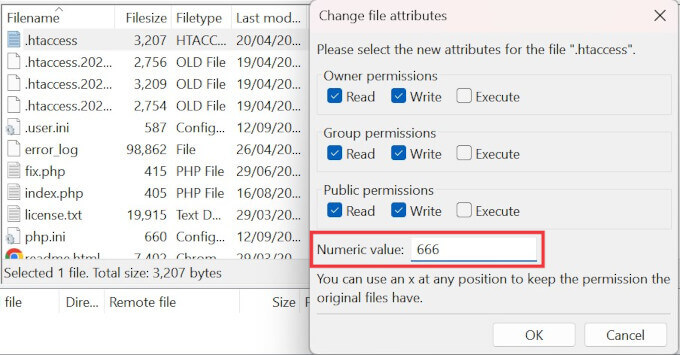
In alternativa, puoi modificare manualmente il file.
Fai semplicemente clic destro sul file .htaccess e quindi seleziona l'opzione Visualizza/Modifica.
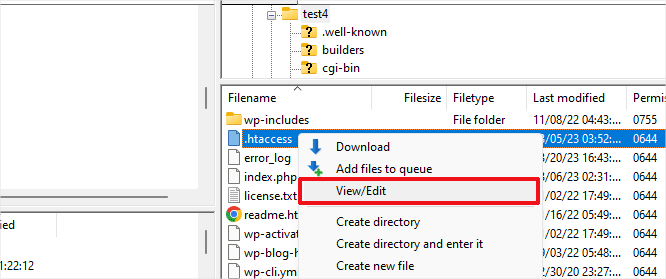
Il file si aprirà in un editor di testo semplice come Blocco note o TextEdit.
Ora devi aggiungere le seguenti regole di riscrittura predefinite di WordPress:
# BEGIN WordPress
<IfModule mod_rewrite.c>
RewriteEngine On
RewriteBase /
RewriteRule ^index\.php$ - [L]
RewriteCond %{REQUEST_FILENAME} !-f
RewriteCond %{REQUEST_FILENAME} !-d
RewriteRule . /index.php [L]
</IfModule>
# END WordPress
Metodo 4: Contatta il tuo provider di hosting
Se nessuna delle soluzioni sopra ha risolto l'errore 404 dei post di WordPress, ti consigliamo di contattare il tuo provider di hosting WordPress. Potrebbe esserci un errore da parte loro o potrebbero essere in grado di aiutarti a risolvere il problema.
Consulta anche la nostra guida su come chiedere correttamente supporto per WordPress e ottenerlo.
Metodo 5: Abilita mod-rewrite (Installazione WordPress locale)
Se stai utilizzando un server locale per scopi di test, dovrai abilitare mod_rewrite nella configurazione Apache del tuo sito MAMP, WAMP o XAMPP.
Questo consentirà a WordPress di generare URL puliti e prevenire l'errore 404 per post e pagine sul tuo server locale.
Il modo in cui lo farai differirà a seconda della piattaforma che utilizzi. Le persone che usano XAMPP possono aprire il loro pannello di controllo e fare clic sul pulsante 'Config' in Azioni. Quindi, seleziona 'Apache (httpd.conf)'.
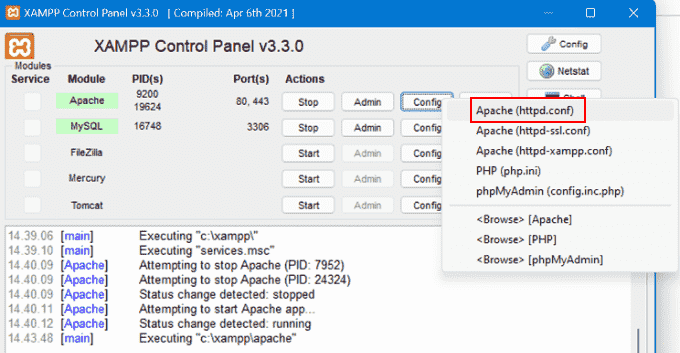
Successivamente, dovrai trovare questa riga #LoadModule rewrite_module modules/mod_rewrite.so e rimuovere il '#' per decommentarla.
Questo caricherà il mod_rewrite.
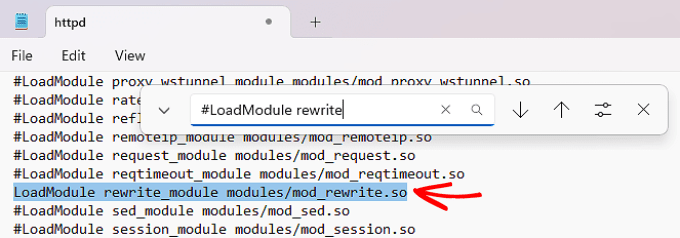
Quindi, cerca le righe che dicono AllowOverride None e cambiale in AllowOverride All. Questo dice ad Apache di consentire l'uso dei file .htaccess.
Di solito li trovi all'interno dei blocchi <Directory>, specialmente quello che punta alla cartella del tuo sito, come htdocs se stai usando XAMPP. Se non sei sicuro, va bene applicare la modifica ovunque la vedi all'interno del file, purché non si tratti di una directory di sistema. Per il testing locale, questo di solito funziona benissimo.
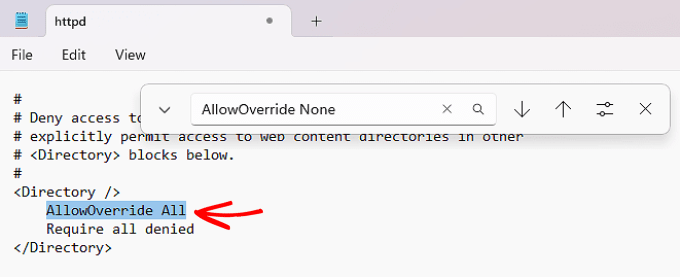
Una volta fatto, puoi salvare il file httpd.conf e chiuderlo. Successivamente, nel pannello di controllo di XAMPP, fai clic su 'Stop' sul modulo Apache e di nuovo su 'Start' per riavviarlo.
Quindi, torna alla tua bacheca di amministrazione per vedere se i tuoi permalink funzionano.
Tutorial video
Se hai bisogno di istruzioni visive, guarda il video qui sotto.
Domande frequenti sugli errori 404 di WordPress
Incontrare errori 404 sul tuo sito WordPress può essere fonte di confusione. Di seguito, abbiamo risposto a domande comuni che possono aiutarti a risolvere e correggere il problema in modo più efficace.
1. Perché ricevo un errore 404 sui miei post di WordPress?
Questo di solito significa che WordPress non riesce a trovare il post all'URL richiesto. Può accadere a causa di permalink interrotti, un file .htaccess corrotto, post eliminati o un conflitto di plugin/tema che modifica la gestione degli URL.
2. Come risolvo un errore 404 in WordPress?
Prova a salvare nuovamente le impostazioni dei tuoi permalink andando su Impostazioni » Permalink e facendo clic su 'Salva modifiche'. Se ciò non funziona, controlla il tuo file .htaccess, disabilita i plugin o passa a un tema predefinito per escludere conflitti.
3. Come posso trovare tutti gli errori 404 sul mio sito WordPress?
Puoi utilizzare Google Search Console per vedere un elenco di errori 404 che Googlebot incontra. Plugin come Broken Link Checker possono anche aiutare a individuare link interrotti e pagine mancanti all'interno del tuo sito.
4. Cosa fa il file .htaccess in WordPress?
Il file .htaccess controlla come vengono elaborati gli URL. WordPress lo utilizza per gestire la struttura dei permalink e instradare gli URL al contenuto corretto. Se è mancante o corrotto, gli URL potrebbero smettere di funzionare correttamente.
5. Come modifico in sicurezza il file .htaccess?
Puoi modificarlo usando un client FTP o il file manager del tuo hosting. Esegui sempre un backup prima. Dopo la modifica, assicurati che i permessi siano impostati su 644 in modo che rimanga leggibile e sicuro.
6. Perché le mie pagine di categoria o tag di WordPress mostrano errori 404?
Questo può accadere se il tuo tema non supporta i modelli di archivio o se le impostazioni dei permalink sono configurate in modo errato. Salvare nuovamente i permalink e verificare il supporto dell'archivio del tuo tema può aiutare a risolvere il problema.
7. Come posso correggere gli errori 404 per i tipi di post personalizzati?
Visita Impostazioni » Permalink e fai clic su 'Salva modifiche' per aggiornare le regole di riscrittura. Inoltre, verifica che il tuo tipo di post personalizzato sia registrato con le giuste impostazioni di riscrittura e abbia il supporto dell'archivio, se necessario.
8. Posso reindirizzare le pagine 404 alla mia homepage o a un'altra pagina?
Sì, plugin come Redirection ti consentono di creare reindirizzamenti 301 da URL vecchi o non funzionanti a quelli nuovi. Puoi anche creare una pagina 404 personalizzata per guidare gli utenti verso contenuti utili.
🎁 Bonus: Guida aggiuntiva sulla gestione degli errori 404
Potresti trovare utili anche le seguenti risorse per la gestione degli errori 404 e altri errori comuni di WordPress.
- Come migliorare il tuo template di pagina 404 in WordPress (2 modi)
- I migliori esempi di design di pagine di errore 404 per WordPress
- I migliori plugin gratuiti per reindirizzare gli errori 404 per WordPress
- Come ricevere avvisi via email per errori 404 in WordPress
Speriamo che questo articolo ti abbia aiutato a risolvere i post che restituiscono errori 404 in WordPress. Potresti anche voler consultare la nostra guida agli errori WordPress più comuni e come risolverli, insieme alle nostre scelte esperte per i migliori plugin WordPress per far crescere il tuo sito.
Se ti è piaciuto questo articolo, iscriviti al nostro canale YouTube per tutorial video su WordPress. Puoi anche trovarci su Twitter e Facebook.





Robert
Beh, il tuo consiglio mi ha risparmiato ore di ricerca – molti grazie
Nima Arefi
Grazie, mi hai salvato la vita :d
Juan
Ciao, ho un problema da quando ho migrato il sito web da localhost a un server, la pagina principale sembra buona ma il menu non viene visualizzato e i link non funzionano sempre, genera un errore 404.
Potete aiutarmi, questa è una causa di una migrazione da un server locale.
Marissa
Non posso ringraziarti abbastanza per un tutorial così semplice!! Tutto il resto che ho trovato lo rendeva così difficile. Ho recentemente cambiato da http a https e è stato un problema dopo l'altro..
Supporto WPBeginner
Ciao Marissa,
Sono contento che tu abbia trovato utile questo tutorial. Non dimenticare di unirti a noi su Twitter per altri consigli e tutorial su WordPress.
Amministratore
Rick
Non avevo un file .htaccess, quindi ne ho creato uno con le informazioni che hai fornito sopra; poi l'ho caricato e il sito funziona di nuovo perfettamente. Grazie!
Curtis
Ciao, ho fatto tutto quanto sopra e ho notato che il pezzetto di testo da copiare e incollare era già presente! Ancora non funziona e mi sto stressando!
Tibi
I’ve done the same thing and nothing changed, the home page still not found
Per favore, contattami se trovi una soluzione
Patrick
Wow. This really saved my bacon. Thank you so much for the tip on simply saving the permalinks page. Incredible advice!
Alexis
Ciao! Ho resettato i permalink molte volte per risolvere l'errore 404. Questa volta, quando ho cliccato su Salva, un file si è scaricato sul mio computer: options-permalink.php e il sito si è rotto. Ho ottenuto solo una schermata bianca e ogni volta si scaricava un file. Alla fine sono riuscito a far funzionare i permalink predefiniti, ma non è una grande soluzione. Ti suona familiare? Il supporto tecnico non pensava fosse il file .htaccess, ma non sono convinto. Ho spostato il sito da un host all'altro. Qualsiasi aiuto sarebbe molto apprezzato.
Mike Birdsall
Come aggiorno le impostazioni se non riesco ad accedere all'area admin di WP? Ricevo l'errore 404 quando vado su /wp-admin
Kelly
Così utile!! grazie!!!!!!
seun
Ciao, per favore aiutami, sembra che non riesca a trovare una soluzione tramite questo tutorial perché non riesco ad accedere alla mia dashboard, continuo a ricevere questo messaggio ogni volta che apro un sito directory.
Not Found
L'URL richiesto /index.php non è stato trovato su questo server.
Inoltre, è stato riscontrato un errore 404 Not Found durante il tentativo di utilizzare un ErrorDocument per gestire la richiesta.
Nukak
se non riesci ad accedere alla tua dashboard. il tuo problema è molto probabilmente un problema di plugin. vai su phpAdmin e disabilita tutti i plugin.
questo link potrebbe aiutarti https://www.wpbeginner.com/plugins/how-to-deactivate-all-plugins-when-not-able-to-access-wp-admin/
una volta disattivati e rientrato, potrai riattivare i plugin di cui hai bisogno. tutte le tue impostazioni iniziali prima di essere bloccato dal tuo sito rimarranno intatte. in bocca al lupo.
Clint
Grazie, è bastato fare clic su Salva nella mia pagina dei permalink (che è stata personalizzata per anni) e ha funzionato immediatamente.
Chris Keeble
Perfetto!
Fare clic su Salva modifiche in Impostazioni > Permalink funziona al primo tentativo.
tamim
Wow! questa è un'ottima soluzione.
Jason
Ciao, stavo avendo il problema dell'errore 404. La homepage funziona bene, tutti gli altri link hanno l'errore 404. Ho provato il metodo che hai suggerito nelle impostazioni di WordPress, permalink e cliccato su salva modifiche, ma non ha funzionato per me.
Ho visto alcuni post in precedenza sulla sincronizzazione del file htaccess tramite la pagina delle impostazioni dell'hosting web, ma non so bene come fare. Qualche consiglio? Grazie
Mohamad Zidani
Ciao
Stavo usando Fv Top Level Cats, quando l'ho rimosso la reindirizzamento ha ancora funzionato da
example.com/category/tech a
example.com/tech.
ho provato la tua soluzione e non funziona.
Joerg Naussed
il 404 appare subito cosa succede?
Tamara
Ha funzionato!! Grazie
Lijo Jose
Grazie, il mio problema è stato risolto
Mariana Cervantes
Thank you so much!!!! My problem was fixed with the permalink solution
Michael
Se questo errore sta interessando la tua pagina di accesso, vai su .htaccess e rimuovi:
“nega tutto”
“consenti da 00.00.00.00”
Matt Kay
Fantastico – avevo spostato il mio sito da un server all'altro e ho iniziato a preoccuparmi degli errori 404. La soluzione ha funzionato perfettamente – così facile!
Bienvenido
Una risposta molto semplice a un problema che fa strappare i capelli. Grazie mille. A proposito, questo problema è iniziato dopo aver installato BJ Lazy Loading.
Gail Gardner
Grazie! Ha funzionato.
Ahmed
Ciao, uno dei miei siti è stato hackerato. C'erano centinaia di articoli inseriti. Ora sono stati rimossi. La console di Google Webmaster li mostra come 404.
Come questo può influenzare il mio sito come posso risolvere questo?
Grazie
Stephanie
Wow, grazie! Ha funzionato perfettamente.
Mawuli Tanor
Perfetto! Puntuale!
La prima correzione ha funzionato.
Grazie mille!
Peter Mazzi
Grazie. Peccato che non ci sia una valutazione in questa pagina. *****
David M. Curtis
Grazie per aver pubblicato questo articolo. Avevo passato mesi a costruire un negozio / blog e oggi nessuna delle mie pagine o post funzionava, ad eccezione della pagina principale, tutti gli altri link mi portavano a un errore 404. Stavo per ricominciare da capo – ripetere mesi di lavoro. Questo articolo ha salvato il mio sito. Ora tutto funziona di nuovo. Non potrò mai ringraziarti abbastanza.
Supporto WPBeginner
Ciao David,
We are glad you found the article helpful Don’t forget to join us on Twitter for more WordPress tips and tutorials.
Don’t forget to join us on Twitter for more WordPress tips and tutorials.
Amministratore
Robin
Ciao, sono completamente bloccato qui, non sono un esperto di computer, quindi è tutto arabo per me. la mia homepage va bene ma ho creato altre 5 pagine come post del blog, servizi, ecc. e ogni volta che provo a visualizzare la pagina che ho appena creato ottengo NOT FOUND "L'URL richiesto /services/ non è stato trovato su questo server". Ho provato a salvare le modifiche, non ha fatto alcuna differenza e non ho idea di cosa sia un FTP. Qualsiasi aiuto? grazie
Supporto WPBeginner
Ciao Robin,
Prova ad aggiornare la struttura dei tuoi permalink. Visita semplicemente Impostazioni » Permalink e poi fai clic sul pulsante Salva modifiche senza cambiare nulla.
Amministratore
Preet Karan
Ciao a tutti,
ho installato il plugin yoastseo. ho generato con successo il sito XML, ma quando l'ho testato su Google Search Console mostra un errore 404.
ho provato il metodo elencato nell'articolo ma il problema persiste ancora.
vorrei anche menzionare che nel CCpanel ci sono due file con lo stesso nome htaaccess e htaaccess.1 (con lo stesso codice scritto che è stato menzionato dall'articolo sopra); è normale,
puoi aiutarmi con il problema
David
Non riesco a credere che cliccare su "Salva modifiche" abbia funzionato. Grazie!
jorge
ciao, ti sarei davvero grato se potessi aiutarmi. Ho seguito le istruzioni per salvare le modifiche ai permalink, non sono una persona esperta di computer, quindi non so come fare altro dopo che mi mostra questo
Errore fatale: Classe ‘Epsilon_Editor_Custom_Control’ non trovata
Supporto WPBeginner
Ciao Jorge,
Sembra che un plugin sul tuo sito web stia causando l'errore. Devi disattivare tutti i plugin installati sul tuo sito web, e poi riattivarli uno per uno finché non trovi il plugin che causa l'errore. Consulta la nostra guida su come disattivare tutti i plugin quando non è possibile accedere a wp-admin per istruzioni dettagliate.
Amministratore
yugal joshi
grande uomo..grazie mille.. ho aperto il mio sito ma dava errore 502 poi 503 e infine 500.. poi ho risolto il problema del 500 da cpanel grazie al tuo post.
ma quando apro le mie pagine dei post mostrava errore 404 poi l'ho cercato su google e ho trovato il tuo post... grazie...
Bren
Nel caso in cui si tratti di un nuovo server o di un aggiornamento di Apache, potrebbe essere necessario verificare quanto segue:
Apri il file httpd.conf, ad esempio: /etc/httpd/conf/httpd.conf.
Cambia AllowOverride None in AllowOverride All.
Salva le modifiche.
Riavvia il server Apache.
Mariyam
Wow, così facile, grazie!
Ashley Adams
Ho un piccolo problema… Dopo aver cliccato su salva modifiche nella pagina dei permalink, è apparso un altro errore 404.
Katherine
Questo mi ha appena fatto risparmiare centinaia di dollari in assistenza. <3
James V
Soluzione rapida… grazie per l'aiuto!
marco
Ho ancora problemi, non so cosa fare, ho seguito i passaggi sopra e ottengo gli stessi risultati. La mia compagnia di web hosting utilizza Windows 2012 Server, quindi non c'è file .htaccess. Molti di questi post di aiuto si riferiscono a .htaccess, che Windows non usa. Usano il file web.config, credo, è corretto? Aiuto per favore
marco
Ho seguito i passaggi sopra, ma ancora non funziona. Sono su Windows 2012 R12 Server e non ho un file .htaccess, anche mostrando i file nascosti tramite FTP. Ci sono istruzioni su come risolvere questo problema quando si è su server Windows?
Supporto WPBeginner
Ciao Marco,
Per prima cosa devi scaricare un backup del tuo file web.config esistente sul tuo computer. Dopodiché devi modificare il file sul tuo server e aggiungere la seguente regola all'elemento system.webServer:
<?xml version="1.0" encoding="UTF-8"?> <configuration> <system.webServer> <rewrite> <rules> <rule name="WordPress Rule" stopProcessing="true"> <match url=".*" /> <conditions> <add input="{REQUEST_FILENAME}" matchType="IsFile" negate="true" /> <add input="{REQUEST_FILENAME}" matchType="IsDirectory" negate="true" /> </conditions> <action type="Rewrite" url="index.php" /> </rule> </rules> </rewrite> </system.webServer> </configuration>1-click Use in WordPress
Amministratore
Salami
Ciao Supporto WPBeginner. Ho provato tutte le soluzioni pubblicate su questo blog per risolvere lo stesso problema (errore 404 su WordPress) che sto riscontrando da due giorni, ma non ci sono riuscito. Sto sviluppando il mio sito web su piattaforma Windows usando WordPress. Per favore, cos'altro dovrei fare per risolvere questo problema?
Grazie in anticipo per la vostra risposta.
Dale
Aiuto incredibile grazie! Semplice come cliccare salva!
david c
Ha funzionato a meraviglia – grazie grazie!
Tom
Molte grazie,
Ha funzionato alla grande!
Michelle
Voglio abbracciarti per tutti i tuoi post estremamente utili. Grazie mille!!!
Steve Andrews
Ho migrato un sito, importato il DB mySQL e caricato l'intera struttura di file della directory di WordPress.
Ho ancora ricevuto un errore 404 per tutto tranne la home page, e il reinserimento della configurazione nella sezione permalink non ha funzionato.
Quello che ha funzionato per me è stato rinominare il file htaccess sul sito FTP in htaccessOLD in modo che non venisse referenziato, ma lo ho ancora di backup se necessario, poi sono andato a salvare le opzioni dei permalink, ho dovuto scegliere che tipo di link volevo (ad esempio data, numero di pagina o descrizione). Una volta salvato, tutte le pagine sono tornate operative.
Grazie per il post, mi ha dato gli spunti per trovarlo e risolverlo.
Rene
Ho seguito esattamente i passaggi ma purtroppo non funzionano per me. Continuo a ricevere errori 404 nonostante abbia salvato le informazioni sui permalink, rimosso .htaccess e rigenerato. Riesco a visualizzare la mia home page, ma non appena voglio visitare una sottopagina, compare l'errore 404. Ho anche provato a passare ai temi predefiniti di WP, anche questo non aiuta. Ci sono consigli per la risoluzione dei problemi "avanzata" in caso di errori 404?
Supporto WPBeginner
Ciao Rene,
Prova ad aggiornare gli URL di WordPress visitando la pagina Impostazioni > Generali. Assicurati che l'URL del tuo sito e l'URL di WordPress siano gli stessi.
Amministratore
sampurna
Ciao. Ho un piccolo problema con il 404. Avevo cambiato il permalink di un singolo post. ora per una certa parola chiave google sta mostrando lo stesso post in due posizioni diverse con lo stesso titolo ma URL diversi e uno ha l'errore 404. per favore aiutami.
Supporto WPBeginner
Ciao Sampurna,
Puoi impostare un reindirizzamento per l'URL che restituisce l'errore 404. Vedi la nostra guida su come impostare i reindirizzamenti in WordPress.
Amministratore
Rene
Non necessario, il problema è risolto. Ho scoperto per coincidenza che il mio host sta leggendo un file .htaccess diverso da quello che WP genera. Quindi è stato necessario un "sincronizzazione" tramite il loro portale di webhosting, tutto qui. Ora funziona, grazie mille comunque e forse questa soluzione alternativa può ancora essere utile per altri che potrebbero avere una configurazione simile con il loro host. Cordiali saluti!
Carey
Anche a me! Ho dovuto "sincronizzare" il file htaccess tramite la pagina delle impostazioni di webhosting... grazie per il suggerimento!
Rajinder S. Gill
This was quick. Thank you
Lois
Mi hai salvato la vita oggi. Ero sul punto di piangere perché dopo aver creato un post, non riuscivo a leggerlo. Restituiva un errore 404. Ho cercato risposte su diversi siti web, ma il tuo post era molto esplicito e una volta cambiata la struttura dei permalink, ha funzionato. Grazie grazie.
Kaylee
Non ho ancora capito esattamente dove cambi i permessi. Potresti per favore spiegare?
Mike lavie
La soluzione: Accedi al tuo server tramite FTP e modifica le cartelle come /wp-content/ e /wp-includes/ sono situate. La cosa più semplice che puoi fare è rendere temporaneamente scrivibile il file modificando i permessi a 777. Quindi ripeti la soluzione originale.
Vai su Impostazioni » Permalink, e fai semplicemente clic sul pulsante Salva modifiche.
Non dimenticare di ripristinare i permessi a 755 ( /wp-content/ e /wp-includes/ ).
Lo faccio perché ora è perfetto!
Lukas
Ottimo, ha aiutato molto!